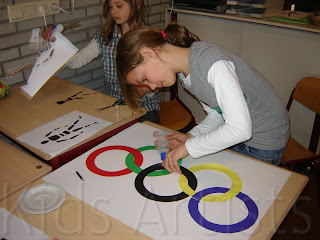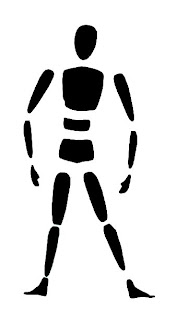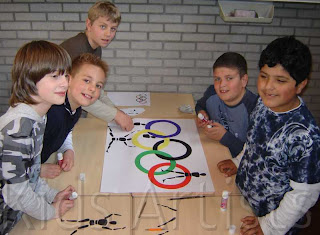You need:
- colored cardboard A3 size
- sponges
- paint rollers
- strips of ribbed cardboard
- bubble wrap
- tempera paint
- brushes
- scissors
- glue
A site with school-tested lessons for the Arts.
Passed holiday's are always full of memories. Sunset on the beach, a sunny afternoon in the woods or impressive clouds above the sea. What colors belong to that memory? What colors belong to a sunset, to the woods and what colors would you use for the upcoming thunderstorm?
Paint your sheet full with your holiday memories using watercolor paint. Paint strips in different colors. After drying, tear the sheet in strips while following the different colors. Glue your strips with a little space between them on the grey/light brown paperboard. Write a title and decorate the frame with little holiday memory doodles (shells, clouds, flowers etc).
Made by students of grade 5
 Start this lesson with the symbol of the Olympics: the colored rings. What do these rings mean? What colors do they have? How are they placed together?
Start this lesson with the symbol of the Olympics: the colored rings. What do these rings mean? What colors do they have? How are they placed together?
 Ask one or two children to take the position of an athlete. What is the position of the legs, arms and body? Ask another student to show another position and discuss it again.
Ask one or two children to take the position of an athlete. What is the position of the legs, arms and body? Ask another student to show another position and discuss it again. Step two:
Every student takes a copy of the body and cuts every part of it. Then these bodyparts have to be pasted around, in, behind and in front of the Olympic rings.
Step two:
Every student takes a copy of the body and cuts every part of it. Then these bodyparts have to be pasted around, in, behind and in front of the Olympic rings.
by students of grade 3
You need:
I did this lesson in grade 5, students worked in pairs. The figures are cut before class. Per art work you need 4 black squares and 16 colored rectangles
Art Noveau was mainly applied to everyday products (for emample furniture, glassware, jewellery), in architecture, graphic art and painting. Artists were inspired by nature: patterns with birds, flowers, plants. clouds, rocks, women. Graceful moving lines express emotion.
Famous Art Nouveau artists are Alphonse Mucha, Gustav Klimt, Gaudi, Berlage.
You need:
Show pictures of Art Nouveau tiles: organic shapes of flowers and plants.
Tell students they are going to build a litte wall of tiles in Art Nouveau style. Every wall has six tiles. Flowers have to be cut out of the folding sheets. Try to use as much as possible of those sheets, so what you cut you glue on the wall.
Artworks made by students of grade 2
Op-art, short for optical art. The word optical is used to describe tings that relate to how we see. Artists use shapes, colours and patterns in special ways to create images that look as if they are moving or blurring. Op art started in the 1960. Op-art is a style of visual art that uses optical illusions. The artwork gives the viewer the impression of movement, hidden images and vibrating patterns.
You need:
Stap 2
Leave the sheet folded in half. Cut the lines up to the 3 cm strip.
Who is Matisse?
Matisse (1869 –1954) was a French artist, known for both his use of colour and his fluid and original draughtsmanship. He was primarily known as a painter.
Matisse didn't care if stones were blue, he just chose the colors he liked. Some people thought is art was very ugly: someone who paints blue faces and green noses is a fool and Matisse was called 'Fauve', which means: wild. This is how the word Fauvism came into being for this art movement, art with bold colors.
After a surgery Matisse spent the rest of his life in a wheelchair. He wasn't able to paint anymore, but could still paint with his scissors.
View various artworks of Matisse.
Cut several circles from scraps of colored paper and paste them om the drawing sheet. Paste smaller circles on the bigger ones. Draw petals using several black markers in several thicknesses.
Source: Krokotak.com
A stained glass window is a window in which several pieces of (mostly colored) glass are stuck in frames of lead. Stained-glass windows were made in times when it wasn't possible yet to make a window in one piece. We see those stained glass windows in old houses, but especially in churches. The light from outside enters in multiple colors into the church.
View stained glass windows and tel about their origin and the effect of the colored light.
Use a white pencil to draw an animal on the black sheet. Draw at least three lines from the animal to all edges of the sheet. Divide the animal into some surfaces.
Make all lines 1 cm wide. Hatch the surfaces between the 1 cm lines with the white pencil.
Cut the white area's. When ready, use the black sheet as a template to draw the pieces of wax paper. Cut them out with an extra 0,5 cm and stick them behind the window. Make sure that there are no two same colors next to each other.
Elements of art: line, shape, color.
Technique: cutting.
Connecting with: history.
You need:
Too difficult or not enough time? Skip step 1 and 2.
Step 1
Draw a square at 2 cm from the edges, this is the outside of the frame.
Step 2
Draw in this square another square at 3 cm of the edges: this is the front of the frame.
Step 3
Draw in the 15 by 15 cm square a simple winter or Christmas scene. Make the lines 1 cm wide and make sure they are on 4 sides attached to the 1 cm wide frame. See pattern below.
Step 4
Color the parts you have to cut out grey.
Step 5
Cut out the grey parts.
Step 6
Cut the corners diagonally, see pattern.
Step 7
Fold the lines of the 15 by 15 square.
Step 8
Stick the corners.
Elements of art: line, form, space.